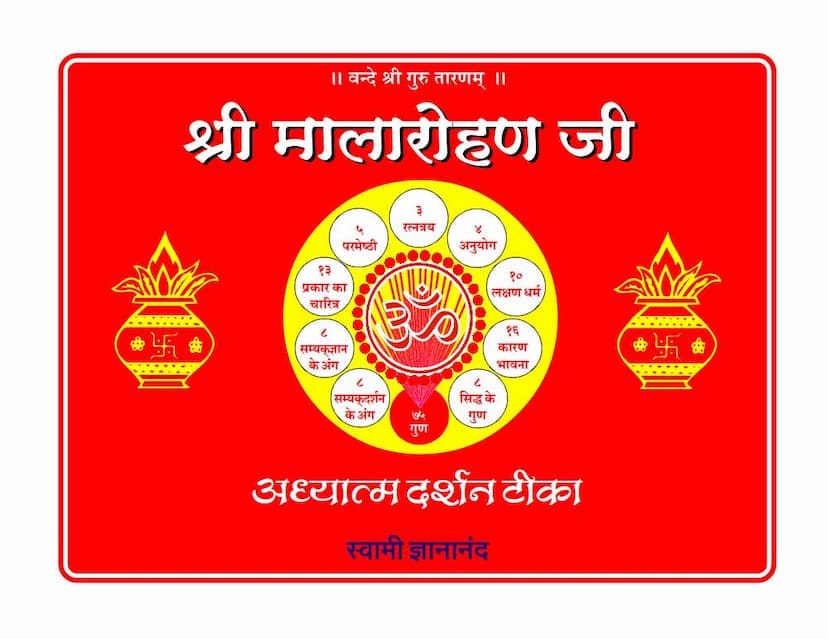Malarohan
Added to library: September 2, 2025

Summary
Here's a comprehensive summary of the Jain text "Malarohan" by Gyanand Swami, based on the provided pages:
Book Title: Malarohan (मालारोहण) Author: Gyanand Swami (ज्ञानानंद स्वामी) (Commentary) Original Author: Acharya Taran Tarana Swami (आचार्य तारण तरण स्वामी) Publisher: Bramhanand Ashram (ब्रह्मानन्द आश्रम)
Overview:
"Malarohan" is a foundational Jain text, part of the "Vicharmat" tradition within Jainism, specifically attributed to Acharya Taran Tarana Swami. The book, as presented, includes a detailed commentary titled "Adhyatma Darshan" (अध्यात्म दर्शन) by Swami Gyanananda. The central theme of "Malarohan" is the exposition of Samyak Darshan (सम्यक् दर्शन), which is considered the first and most crucial step on the path to liberation (Moksha).
Key Concepts and Themes:
-
The Importance of Samyak Darshan: The text emphatically states that Samyak Darshan is the "first step" and the "foundation" of true religion and the path to Moksha. Without it, even extensive knowledge (Samyak Gyan) and conduct (Samyak Charitra) are considered incomplete or ineffective, like a number without a preceding zero. It is the key to overcoming the cycle of birth and death (samsara) caused by mistaken identity (mithyadarshan).
-
The Nature of True Religion: The commentary highlights that true religion (Dharma) is characterized by the "consciousness of one's own pure soul" (chetan lakshan dharm). It is not about external rituals, austerities, or accumulating merit, but about realizing the true nature of the soul – as pure, knowledgeable, blissful, and eternal.
-
The Soul (Atma): The text describes the soul as pure consciousness, the abode of bliss and infinite powers, distinct from the body and other material possessions. The core spiritual journey involves realizing this true self.
-
The Path to Liberation (Moksha): "Malarohan" outlines the "Ratnatraya" (रत्नत्रय) – the three jewels of Samyak Darshan, Samyak Gyan, and Samyak Charitra – as the path to liberation. The title "Malarohan" itself implies "ascending the garland" or the path of these three jewels.
-
Identification and Decision: A significant emphasis is placed on "Vicharmat" (विचार मत), which means making a deliberate, intellectual, and conscious decision about one's true self. This involves introspection on fundamental questions:
- Who am I? (मैं कौन हूँ?) - I am the soul, not the body.
- Where have I come from? (मैं कहाँ से आया हूँ?) - From the cycle of birth and death.
- What is my true nature? (मेरा स्वरूप क्या है?) - I am knowledge, bliss, and consciousness, formless, and untouched by external substances.
- Where do I need to go? (मुझे कहाँ जाना है?) - To Moksha.
-
Bhed Gyan (भेदज्ञान) and Tatva Nirnay (तत्व निर्णय): These are presented as fundamental practices for realizing the soul.
- Bhed Gyan: The understanding that "I am the soul, an indivisible, eternal, conscious entity, distinct from this body and all other external things. This body and these things are not mine."
- Tatva Nirnay: The realization that whatever happens to any being or substance at any given time is according to its inherent nature and destiny, and cannot be altered.
-
The Role of Acharya Taran Tarana Swami: The text reveres Acharya Taran Tarana Swami as a revolutionary spiritual figure of the 16th century who emphasized the importance of pure spirituality, free from outward show and rituals. He is credited with composing 14 significant works, including "Malarohan," which are seen as guiding souls toward liberation.
-
The Commentary by Swami Gyanananda: Swami Gyanananda's commentary is praised for its simplicity, clarity, and profound spiritual insight, making the original text accessible to spiritual seekers. His own spiritual journey and practices are alluded to, adding depth to the exposition.
-
The "Taran Triveni": "Malarohan" (Samyak Darshan), "Pandit Puja" (Samyak Gyan), and "Kamal Battisi" (Samyak Charitra) are collectively referred to as the "Taran Triveni" (तारण त्रिवेणी) or "Three Battisi" (three sets of 32 verses), forming a comprehensive guide to the Ratnatraya.
-
Characteristics of a Samyag Drishti (Right-Believer): The text elaborates on the internal and external signs of a soul who has attained Samyak Darshan. Internally, they experience indescribable bliss, freedom from doubts and illusions, and a clear understanding of self and non-self. Externally, their conduct reflects detachment from worldly desires and a life lived in accordance with their true spiritual nature.
-
The "Pachhatar Gun" (Seventy-Five Qualities): The text mentions that the enlightened soul (gyani) weaves a garland of these qualities through spiritual practices, referencing divine qualities (5), Guru's qualities (3), scriptures (4), qualities of the Siddha (8), 16 cause-qualities (Sola Karan Bhavana), 10 characteristics of Dharma (Dashlakshan), and the qualities related to Samyak Darshan, Gyan, and Charitra.
-
The Nature of True Happiness: True happiness (Anand) is not found in external possessions or worldly pleasures, which are temporary and ultimately lead to suffering. It is an internal state of bliss derived from the realization of the soul's true nature.
-
The Importance of Self-Enquiry: The text encourages continuous self-reflection and enquiry into one's true identity, distinguishing the eternal soul from the transient body and external circumstances.
-
Overcoming Obstacles: The commentary addresses potential misunderstandings and challenges on the spiritual path, emphasizing the need for perseverance, detachment from worldly entanglements, and continuous effort in spiritual practice.
In Essence:
"Malarohan," through its commentary, serves as a profound spiritual guide for Jains, particularly within the Taran Panth tradition. It steers practitioners away from mere external observances towards the internalized realization of the soul's true nature. The emphasis is on understanding oneself, making correct decisions based on wisdom, and following the path of the three jewels (Samyak Darshan, Gyan, Charitra) to achieve ultimate liberation and eternal bliss. The text is a testament to the power of sincere introspection and the guidance of a true spiritual master.